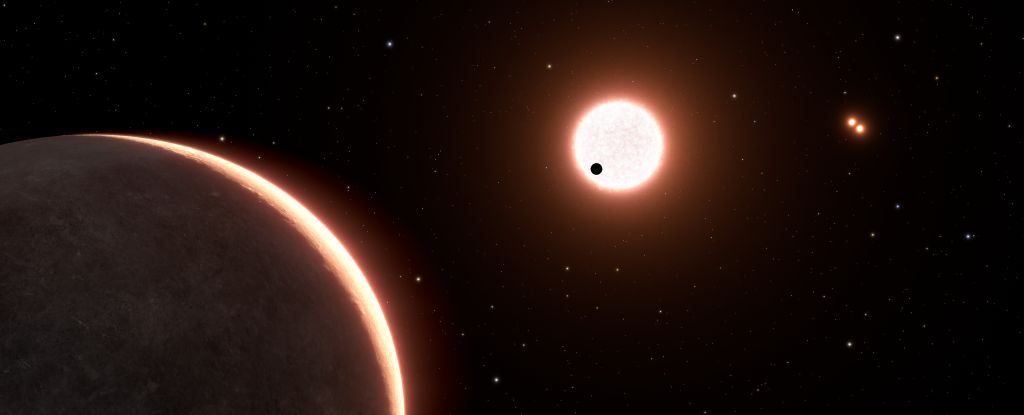
Just 22 light-years away, orbiting a small red dwarf star, there is a tiny world that scientists from the United States have confirmed is the closest known Earth-sized world to our solar system.
It is called LTT 1445 Ac, an exoplanet with a mass 1.37 times that of the Earth and 1.07 times the radius of our planet.
Although this world is unfortunately too hot for human life, its similarity to our own planet makes it an analog of Earth – a world so close to our own that we can use it to study how planets evolve and what makes one world like Earth so different from another.
LTT 1445 Ac was first identified using data from the TESS exoplanet search telescope in 2021, but there were some observational difficulties that made astronomers unable to be sure of its properties.
The exoplanet is located in an unusual system: The star around which it orbits is one of three stars gravitationally bound in a triple system.
Scientists find and study exoplanets by observing changes in the light of the host star; but in multistellar systems, companion stars also affect the light of other, neighboring stars. Although 22 light-years is relatively close, a world the size of the Earth is quite a small thing to try to see in detail.
To understand the properties of an exoplanet, two types of measurements are ideally needed. The first is transit data: tiny dips in starlight that occur when an orbiting exoplanet passes between us (the observers) and the star.
The second is the radial velocity data; it measures how strongly the exoplanet’s gravity pulls the star by recording changes in the wavelength of starlight as the star oscillates in place every minute.
The passage data shows the radius of the exoplanet, which can be calculated based on how dim the light of the star becomes during the passage. The radial velocity data indicates the mass of the exoplanet.
Together, the radius and mass allow us to determine the density of the exoplanet – and on this basis, we can make a very accurate estimate of what the exoplanet is made of.
Low density means a lot of atmosphere, like a gas giant. Higher density means a rocky composition, like that of the Earth, Venus, Mars, or Mercury.
TESS detects planets using the transit method, but the TESS data on LTT 1445 Ac was of poor resolution, so it is difficult to say whether the eclipse was the result of the entire planet obscuring starlight or only part of the planet “grazing” the Sun’s disk.
The presence of the exoplanet was confirmed using radial velocity data. But to better understand the planet’s properties, we needed higher-resolution transit data.
This is where the Hubble Space Telescope comes in. Using Hubble’s Wide Field Camera 3, a team led by astrophysicist Emily Pass of the Harvard and Smithsonian Centers for Astrophysics observed the LTT 1445 system, looking for transits of LTT 1445 Ac.
Some of the starlight dips in the system were the result of the interaction of the three stars with each other; and some of the uncertainty in the TESS data was the result of these interactions. But the team was able to capture the exoplanet crossing the star’s surface, and thanks to this, Pass and her colleagues were able to obtain a high-resolution measurement of the diameter of LTT 1445 Ac.
With the radius and mass in hand, the researchers were able to determine that the world has a density of 5.9 grams per cubic centimeter. The earth has a density of 5.51 grams per cubic centimeter. This suggests that LTT 1445 Ac is likely a rocky exoplanet very close to Earth in size and composition.
Life as we know it can hardly exist on it. Its host star is a red dwarf, colder and dimmer than the Sun, but the exoplanet’s orbital period is only 3.12 days, which means its temperature is about 260 degrees Celsius (500 degrees Fahrenheit).
However, the ability to obtain clear data on transit means that there is a good chance to look into its atmosphere.
Further characterization of the exoplanet can help us understand how Earth-like worlds form and evolve in other system architectures, which in turn can help scientists determine the likelihood of life in other parts of our galaxy.
“Transiting planets are very interesting because we can characterize their atmospheres using spectroscopy not only with Hubble but also with the James Webb Space Telescope,” Pass says.
“Our measurement is important because it shows us that this is probably a very close Earth-like planet. We look forward to further observations that will allow us to better understand the diversity of planets around other stars“.
The study was published in The Astronomical Journal.

